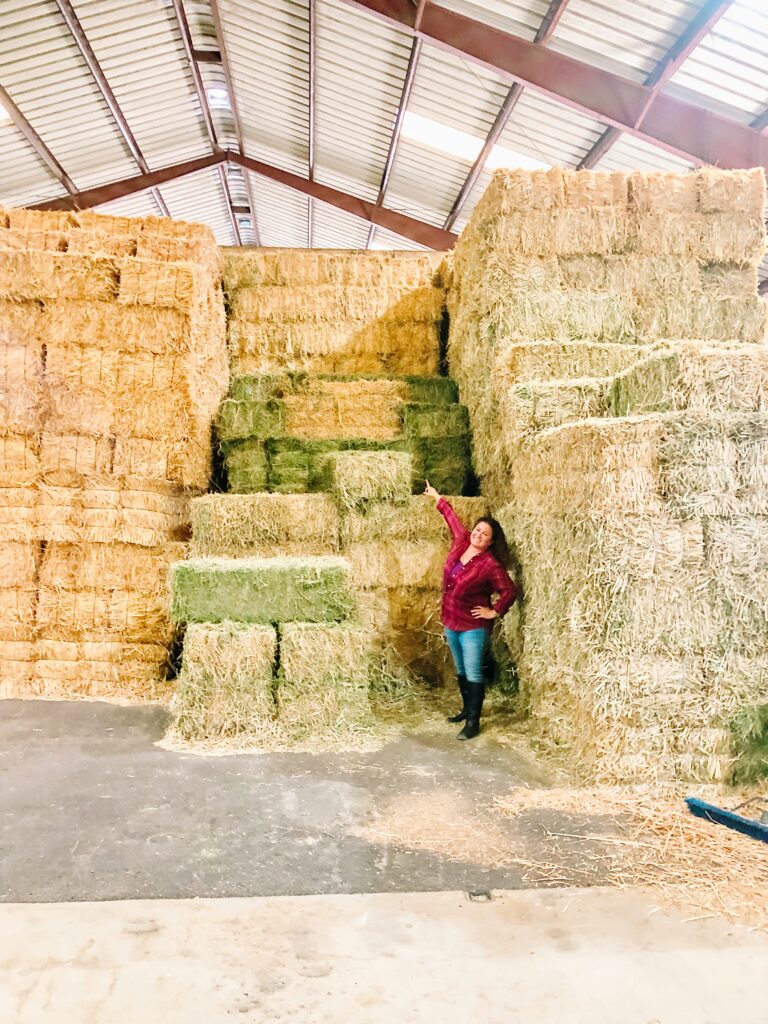Have you ever wondered what it was like to travel in a stagecoach back in the day? Then step right up into one of Knott’s Berry Farm historical Stagecoaches. The Butterfield Stagecoaches at Knotts are authentic stagecoaches representing those that were used by the Butterfield Overland Mail Company. During the days of stagecoach travel, the Butterfield Overland Mail Company transported people and mail from St. Louis, MO and Memphis, TN to San Francisco, CA.
I recently visited the offsite barn at Knott’s Berry Farm that houses all of the stagecoaches plus the horses that pull them. (This is not available to the general public. I am a Knott’s Berry Farm Ambassador). While I was there, I had the wonderful opportunity to speak with Kevin Norris, director of operations and horse aficionado, who took me on a tour around the property.
I did a Q&A with Kevin and I learned a ton of information about the history and the logistics that goes into The Stagecoach Ride as well as a tour of the property.
Be sure to watch my interview with Kevin below for more in depth information and also a behind the scenes tour where I meet a lot of the horses! You can absolutely see that these horses are extremely well loved.
Answer Key: FRG= Family Review Guide | KN= Kevin Norris
FRG: How many horses are on the property?
KN: There are 38 horses currently on the property.
FRG: Where do the horses of Knott’s Berry Farm come from?
KN: We find primarily thoroughbreds that are ex-racehorses from a buyer in Carbon Canyon.
FRG: What are the names of the horses?
KN: We only have male horses. Some of the names are: Sox, Tuffy, Chico, Ben, Brego, Dan, Ike, Smokey, Lucky, Mike, Chip, Kirby, Stan, john, Champ, Junior, Caesar, Fury, Barney, Guido, Elmer, Steve, Rusty, Walt, Sid, Ed, Rocky, Rollout, Spike, Jesse, Bullet, Bear, Walter and Dave.
FRG: Any fun or interesting facts about the horses?
KN: Yes, I have several facts. The First fact is our horse Lucky had a chemical imbalance similar to being a diabetic. We don’t always know the history of the horses, so when we first got him we were feeding him alfalfa, not aware of his issue. We had the vet come out and we were going to put him down but we ran some blood work and solved the problem and we were able to save his life! That is why his name is Lucky.
KN: Second fun fact – On our hitch board there are wheeler horses and leader horses. When the consensus is that any person can go around the horse safely, only then do they get a name. Until then they are referred to by a number. (horses that have not been broken yet also have a number).
KN: Third fun fact- When a horse makes the team they get their mane shaved and they get a name.
FRG: Who is the oldest horse that works at Knott’s?
KN: Dave, Clark and Ted. They are all around 23-24 years old.
FRG: How much food do they go through per week?
KN: Each horse will get fed on the density of the bale. They get alfalfa in the afternoon and in the morning they get hay depending on the time of the year. So the 38 horses will go through 8-9 bales in the summer and about 6 bales in the winter time. Each allocation of feed weighs about 25-30 lbs.
FRG: How are the horses trained to pull the stagecoach? Do the handlers get special training too?
KN: The horses go through a “sacking out” period where we get them used to the harness, we get them used to pulling with another horse, and then we spend some time out in the park. It depends on the horse but that could last anywhere from a week to a month. Our drivers go through a period of training for about 3-6 months. In terms of their capabilities, they need to show they have control of the speed, control of their line adjustment and the horse’s overall demeanor.
FRG: Could you tell us a bit about the tack (gear) the horses wear while they’re working the stagecoach?
KN: The horses have a very heavy harness that is capable of withstanding a lot of problems in terms of the horse. They also wear heavy collars that are attached to haines, traces, a back pad and spider. It takes about 15 minutes to fully gear up our horses.
FRG: How often do the horses get new shoes?
KN: Every 6-8 weeks.
FRG: Any fun facts about the Stagecoaches in the park?
KN: There are 6 stagecoaches and the Knott’s Berry Farm & Ghost Town stage coach was built in 1955 in Arkansas at a cost of $25,000. It is thought that all of the stagecoaches were in movie sets or are originals.
FRG: What do the horses do when they are not working stagecoach?
KN: They get to relax in the Livery Barn. They enjoy the camaraderie with the guests.
FRG: Do the horses walk the entire stagecoach ride or do they gallop at any point?
KN: Their gate is just above a walk. So in between a trot and a walk.
FRG: Out of All the horse who has the friendliest personality.
KN: Lucky! OK, Dave and Ted and Clark too!
FRG: How do the horses stay cool on hot summer days?
KN: We spray them down with a hose and we have a water trough that is on casters that we put in front of the horses. They do it every 15 minutes or every three rounds.
FRG: How is caring for the 2 donkey’s, Brutus and Betty different than caring for the horses?
KN: They get different types of feed and we also keep a closer eye on them and make sure they do not get overworked. They do not work the same way the horses do. However, they love to hangout together in the turnout Pen.
Watch My Interview With Kevin and Learn About The Stagecoaches
Behind The Scenes: Come Meet The Horses of Knott’s Berry Farm
Stagecoach Rider Safety Information
- You can take a ride on one of six stagecoaches, five of which are authentic, and used in the 1800s. The trail travels around Fiesta Village® and Camp Snoopy®.
- Wait at the ride exit located to the south of the attraction entrance. A Guest Service Associate will direct the guest and their escort to a seat.
- Riders must be able to maintain an upright and stable position. Riders must be able to negotiate five stairs to access the entrance of the attraction. Guests in wheelchairs will be directed up the exit ramp and then loaded into the coach. To board the coach, guests must be able to step up 13” and transfer to their seats.
- Each rider must be able to remain sitting up straight, keeping their head upright, their back and shoulders against the seatback, and their hands, arms, legs, and feet down and inside the ride at all times. Riders must be able to hold on with one functioning arm and brace with one functioning leg. Two functioning arms are sufficient instead of one functioning arm and one functioning leg if the guest has a normal center of gravity, and the lower extremities are sufficiently strong to maintain proper riding posture under the dynamic conditions of the ride. Amputations must be at the knee or below. Riders must have a minimum of two functioning extremities. Riders with a full leg cast can participate, providing the leg cast can fit inside of the ride, and the restraint system can be used as designed. Please review all restrictions listed on the sign at the attraction entrance.
- Service animals may accompany the guest on this attraction.
- The guest and their companion must be able to negotiate five, 7” steps to sit on the top of the stagecoach.
- Due to unforeseen circumstances, it may be necessary to exit the Stagecoach in a location other than the loading dock. Guests must be able to step out of the coach and onto a ladder, a maximum of 8’. From there, guests will be escorted to the nearest exit.
- Visit the Guest Assistance Guide for additional Accessibility information.
Thank you Knott’s Berry Farm for this awesome opportunity!




I love horses, back in 1961 we moved from Wyoming to B.P. Calif. Knotts Berry at that time ×as fun to walk around in,didn’t have money to ßpend. On our walking I found a dapple g=4y horse that was swayback,bad, I would love to know his history. I know he was in some movies. Thank you.